Nvidia’s New Quadro Cards Whip Up A Storm
Published:
Nvidia has released five new cards, although none of them unseat the K6000 as their flagship professional graphics solution. By then end of September 2014 all of these cards should be available for purchase, although we always recommend checking with us first when enquiring about a specific component. Each of these cards has a unique place in terms of market segment and intended purpose, so we’ll look at them individually starting with the entry-level unit, the Quadro K420.
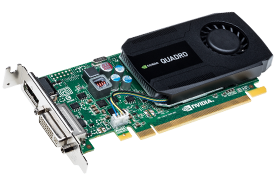
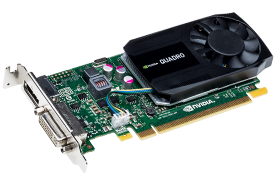
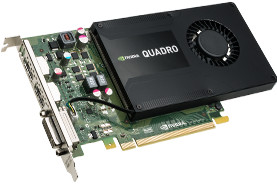
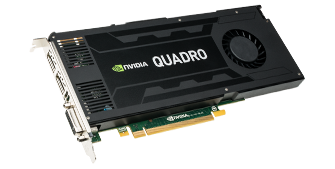
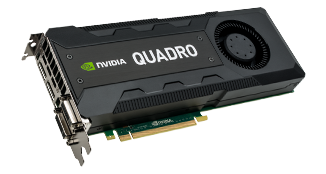
Nvidia Quadro K420, K620, K2200, K4200 and K5200
Quadro K420
The Quadro K420 is, as you might expect from the number, an entry-level card. In terms of performance it certainly isn’t going to set any benchmarks on fire, but at 40W TDP with professionally certified drivers and a sub-$200 price point there’s much to like about the K420.
The K420 is based on the Kepler GK107 GPU, but has 192 CUDA cores rather than the reference design’s 384. As standard this card comes with 1GB of DDR3 RAM with a 128-bit bus. The maximum supported resolution (using Displayport 1.2) is 3840x2160, which is of course the 4K video standard. This makes the K420 a good card for working with 4K content. Light CAD/CAM tasks and low-end 3D renderings should also not pose a problem. It also helps that this is an ultra-quiet, low profile unit, making it even more attractive for a studio environments. On top of this, the K420 supports up to four displays simultaneously (with an MST hub), which is a pretty attractive workstation feature in such a low-cost card.
Quadro K620
Unlike the K420, the K620 sports the new Maxwell GPU design instead of the older Kepler chip. The K620 has 384 CUDA cores, a 128-bit memory bus and 2GB of DDR3 memory. The K620 replaces the K600 and it appears to be quite a bit faster than its predecessor.Memory bandwidth remains unchanged, so if that was a performance constraint before it won’t be any different this time around, there is however twice as much RAM available compared to the K600, which certainly makes the K620 much more versatile as a workstation card. Like the K420 the K620 is a low-profile, low power card. Clocking in at a mere 45W. Therefore, it too is very promising as a quiet environment graphics application where CPU power is more important than GPU power, but you still want the stability offered by workstation grade components. Between these two cards it really comes down to how much you need the extra grunt, because in other respects they are by and large the same.
Quadro K2200
The K2200 is the first of the “serious” parts of those discussed here. Despite not being the most powerful card here, in one way the K2200 is a flagship card. It is one of the most powerful sub-75W workstation cards available. If we keep the K2200’s power budget in mind, the specifications are all the more impressive. The Maxwell-based K2200 comes with 640 CUDA cores and 4gb of RAM, clocked at 1Ghz and 5Ghz respectively. The memory is fed by a 128-bit bus. The K2200 outperforms its predecessor, the K2000, by 78%, which is one of the larger generational leaps we’ve seen. At single precision this card will do 1.3 TFLOPS.
The K2200 is certainly in a position to make more expensive cards from the previous generation sweat a bit, in performance testing the K2200 decisively outperforms the K4000 in all but a few benchmarks. In fact, the K2200 isn’t that far off the pace of the next two cards on the list. For a sub-$500 card the K2200 throws quite a punch indeed.
Quadro K4200
Speaking of the K4000, it’s official replacement comes in the form of the K4200. The K4200 brings an overall 75% performance bump compared to the K4000. That’s 2.1 TFLOPS achieved with 1344 CUDA cores and 4GB of RAM at a cost of 105W at the outlet. A very welcome new feature on the K4200 is the inclusion of Quadro Sync, which was previously exclusive to the K5000 series. The K4200 represent the current performance cap on single-slot Quadro cards and a relatively modest power draw. For small form factor builds this is about as good as it gets at present and the K4200 certainly raises the bar for entry into the high-end segment.
Quadro K5200
While not quite toppling the K6000, the K5200 is nevertheless a beast of a card. 2304 CUDA cores, a 256-bit memory bus and 8GB of RAM is nothing to sneeze at. That’s a 36% increase in compute power and an 11% increase in memory bandwidth compared to the K5000. The K5200 also adds support for ECC memory, a feature that was lacking in the K5000. There isn’t much more to say about this brute other than that it is a brute. What is significant is the fact that Nvidia was able to put this much high-end performance into a card capped at the 150W level.
These new cards are definitely worth looking into, even if you are currently using their immediate predecessors. Performance improvements, especially in terms of performance-per-watt has improved tremendously throughout the range. It’s also very nice to see high end features from higher cards move down to the K4000 series. All the cards listed here save for the K420 are easy to recommend, in the case of the K420 you would only choose this card if you absolutely could not afford the K620, but our recommendation would be to go for bigger sibling if at all possible. Nvidia have once again shown why they are still a dominant force in professional graphics and we’re excited to see what builds we can come up with using this new generation of GPUs.